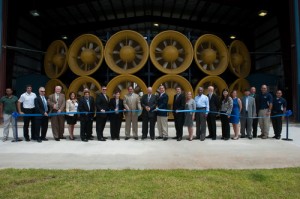Wall of Wind (WoW) — A collaborative project between International Hurricane Research Center (IHRC) and College of Engineering and Computing (CEC) at FIU:
- Holistic full-scale simulation of hurricane wind forces, turbulences and vortices.
- Coupling/hybridizing dynamic wind loading with nonlinear structural/material response.
- Monitoring performance levels and progressive damages for different wind force levels.
- Providing a controllable, programmable, and repeatable hurricane test environment.
- Eliminating scaling issues, and yielding realistic Reynolds and Strouhal numbers.
- Simultaneous testing for high wind forces and impinging rain.
- Simultaneous testing of high wind forces and wind-borne debris impact on components and the entire structure, including the effects of breach of envelope on internal pressure.
The first prototype, created by experts from FIU’s wind engineering team, was assembled in 2005. The original 2-fan mobile unit used two 450 HP gasoline engines to generate 120 mph winds and included a water-injection system to simulate horizontal rain. Tests were done on light commercial roofs, barrel tile roofs, and rainwater intrusion under eaves. This paved the way for the larger RenaissanceRe 6-fan Wall of Wind (sponsored by RenaissanceRe Holdings Ltd.) in 2007, which used six 500 HP gasoline engines with the ability to simulate hurricane wind characteristics and engulf large-scale structures. In 2012, the new 12-fan Wall of Wind was developed and uses twelve fans, each powered by a 700 HP electric motor, for a total of 8,400 HP for the entire system. This large-scale hurricane research and testing facility is capable of reaching Category 5 wind speeds of 157 mph and can be supplemented with wind-driven rain. This newest system is capable of performing controlled and repeatable to-scale testing in flows that replicate the type of winds seen during Hurricane Andrew – one of the costliest storms in US history. The mean and turbulence wind parameters, closely matching hurricane characteristics, are achieved through the application of a special flow management device.
To learn more about the Wall of Wind, please visit: http://wow.fiu.edu.

